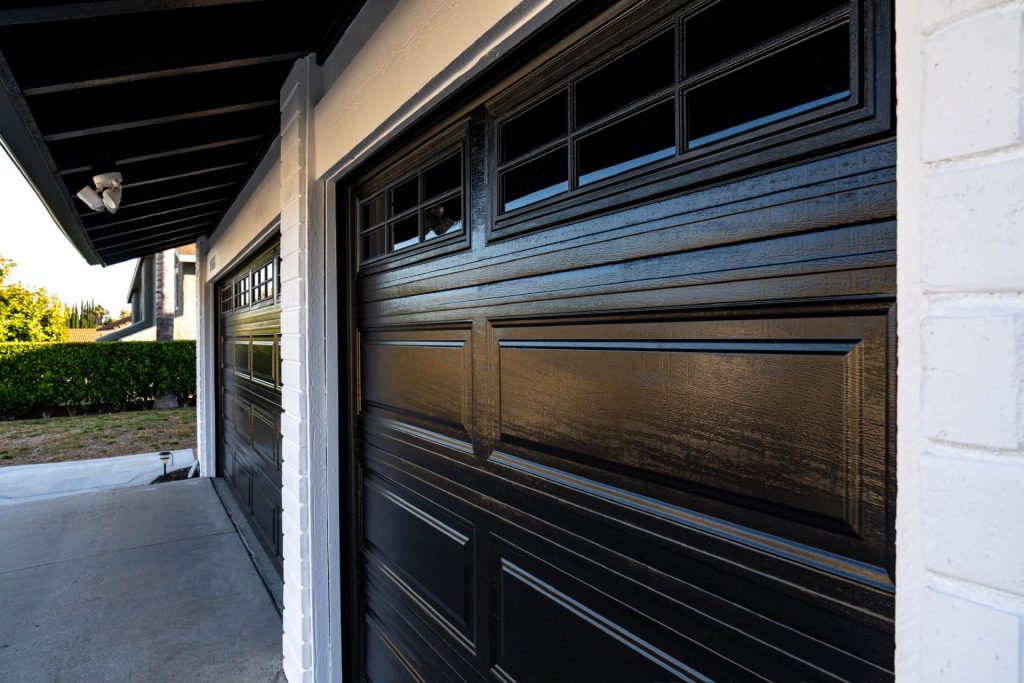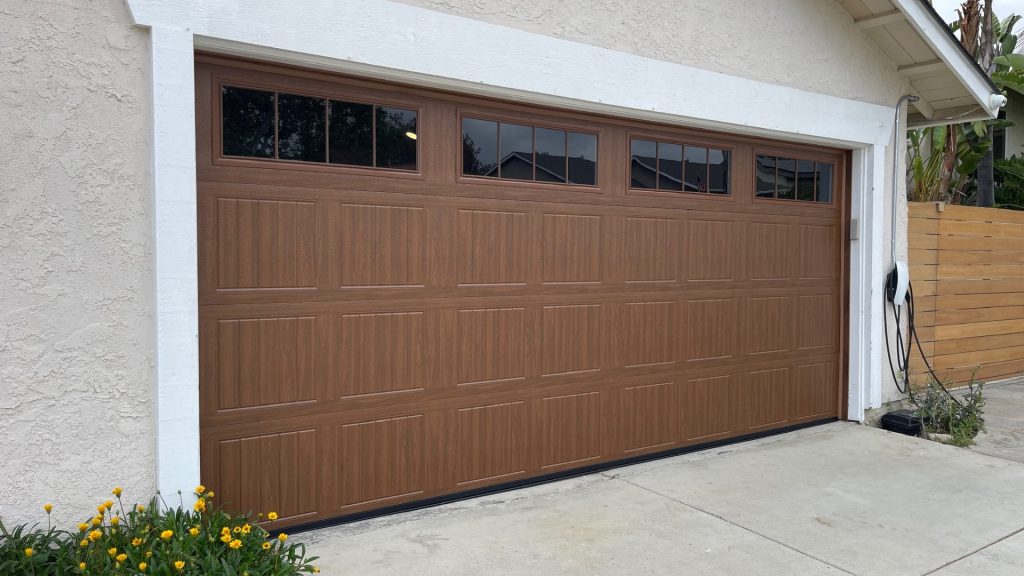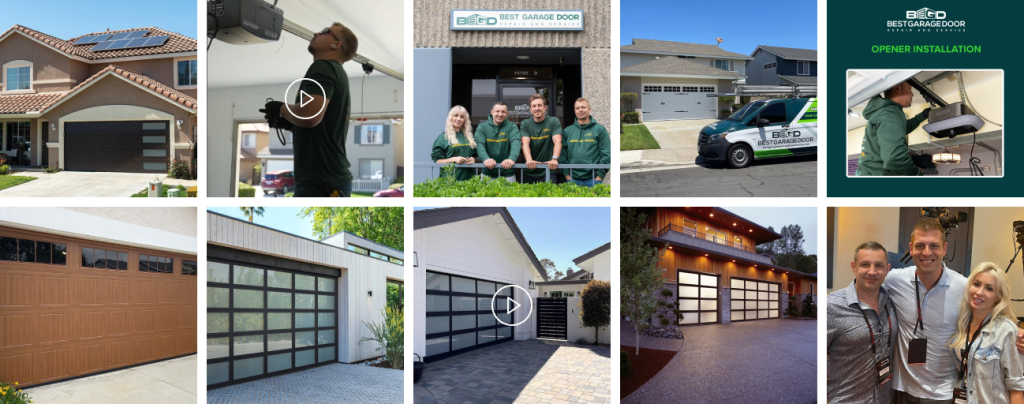Painting your garage door is not just about aesthetics; it’s crucial to enhancing your home’s appeal and durability. This endeavor enhances the visual allure of your property and fortifies it against external elements, thereby prolonging the lifespan of your garage door. By carefully selecting the right paint and preparing your door, you can achieve a look that combines style with function, making your home stand out and better protected.
Preparing your garage door for painting
Proper preparation of your garage door is critical for achieving a successful and durable paint job. Here are detailed steps to ensure your door is optimally ready for transformation:
Assessing Your Garage Door's Condition
Material And Paint Check:
- Identify your door’s material — wood, metal, vinyl, or fiberglass — to choose the correct type of paint and primer.
- Examine the existing paint for peeling or cracking. Doors in poor condition may require more intensive preparation, such as stripping or thorough sanding. Doors with intact paint may only need light sanding to ensure the new paint adheres effectively.
Pre-cleaning and surface preparation
Cleaning The Door:
- Create a cleaning solution with trisodium phosphate (or a biodegradable cleaner) using 1/3 cup per 1-1/2 to 2 gallons of water.
- Use a 3M synthetic steel wool pad (gray, not green) to apply this solution, scrubbing evenly to slightly scuff the surface and remove dirt, oil, caulk, waxes, and mildew.
- Ensure a meticulous rinse using fresh water and a sponge, with regular water changes, to guarantee the complete removal of any lingering residues.
- Finally, wipe down with a clean, damp sponge to remove any loose material.
Surface sanding:
- Lightly scuff the exposed surface of overlays, window grilles, and window frames with medium-grit sandpaper.
- Be cautious about sanding only damaged areas on steel portions to avoid removing rust-inhibiting compounds.
Necessary tools and materials
Tools For Painting:
- Brushes and rollers for detailed and broad surface painting. Consider a paint sprayer for an even coat over large or intricately designed doors.
- Sandpaper and sander are used to smooth surfaces and remove old paint.
- Use high-quality exterior paint suitable for the door’s material and climate conditions. Ensure the paint is compatible with the garage door material and follows specific guidelines (e.g., solar reflective properties for certain materials).
Primer Selection:
Choose a bonding primer to improve paint adhesion. Recommended primers include Sherwin Williams DTM Bonding Primer or PPG Seal Grip®.
Protective Gear And Materials:
Use drop cloths, painter’s tape, and safety gear to protect yourself and your surroundings during the project.
Eco-friendly tip
Environmentally Friendly Options:
Opt for low-VOC or no-VOC paints and primers to minimize environmental impact and health risks.
Choosing the right paint for your garage door
Selecting the appropriate paint is crucial for ensuring your garage door’s durability and aesthetic appeal. This comprehensive guide is your companion in mastering the intricacies of paint choices, elevating your door’s practicality and visual allure.
Understanding Paint Types And Finishes
1. Appropriate Paint Choices:
- High-quality acrylic latex paint: Your garage door should be painted with 100% acrylic paint, suitable for exterior surfaces. This type of paint is available in flat, satin, or semi-gloss finishes and offers durability and weather resistance.
- Bonding primers: A bonding primer is strongly recommended before applying the top coat for better adhesion. Recommended products include Sherwin Williams DTM Bonding Primer, Sherwin-Williams Bond-Plex Acrylic Coating, and PPG Seal Grip®.
2. Special Considerations For Material:
- Wood doors benefit from breathable acrylic latex to prevent moisture retention.
- Metal doors require rust-preventing acrylic latex or direct-to-metal paints to prevent corrosion.
- To maintain vinyl doors, opt for specialized flexible paints engineered for plastic surfaces, guaranteeing optimal adhesion and durability.
3. Finish Implications:
- Semi-gloss finishes are practical and popular due to their ease of cleaning and moderate shine, highlighting architectural details.
- Satin finishes Offer a more subdued look but are equally durable and easy to maintain.
Understanding light reflectance and composite material safety
The paint color’s Light Reflection Value (LRV) is crucial when painting garage doors, especially composite materials. LRV, an essential metric, gauges the balance between light reflection and absorption of color, which is vital for assessing surface heat accumulation.
Dark colors typically have low LRV and absorb more sunlight, which can lead to higher surface temperatures. This increase in temperature can be detrimental to composite materials, which may begin to degrade when exposed to excessive heat. The degradation can manifest as warping, expansion, and other structural deformities.
To prevent such issues, it is recommended to use lighter colors or specially formulated solar reflective paints. Crafted specifically for this purpose, these paints effectively deflect sunlight, minimizing heat absorption on the surface of your door. This not only preserves the integrity of the material but also enhances the door’s longevity and performance.
It is essential to ensure that the paint used is suitable for the specific type of composite material, adhere to manufacturer guidelines to avoid potential damage, and ensure that warranties remain valid.
Color selection to boost your home's aesthetic
4. Matching Or Contrasting:
- Harmonize your garage door’s hue with the overall palette of your residence for a unified appearance, or opt for a contrasting shade to draw attention as a standout feature.
- Consider your home’s architectural style and the surrounding environment when selecting colors.
5. Testing Before Finalizing:
- Apply paint samples in a small section to observe how the color appears under different lighting conditions throughout the day. This ensures the selected color meets your expectations in all lighting scenarios.
Eco-friendly considerations
6. Low-VOC Options:
- Prioritize eco-friendly options by selecting paints and primers with low or zero VOC content. This will reduce your environmental footprint and promote healthier indoor air quality during painting.
Crafting a meticulous pathway for reviving your garage door with paint: A comprehensive walkthrough
Transform your garage door with these comprehensive steps for a standout look, ensuring both charm and protection for your home
Cleaning and prepping the door
1. Cleaning:
- Start by thoroughly washing the door to remove dirt, oil, and residues. Make a solution using trisodium phosphate or a biodegradable cleaner mixed with 1-1/2 to 2 gallons of water.
- Employ a synthetic steel wool pad to cleanse the surface delicately, ensuring the preservation of the current finish without harming it.
- Ensure a thorough rinse with fresh water, then let the door air dry entirely for optimal results.
2. Sanding:
- Lightly sand the door using fine-grit sandpaper to smoothen the surface and improve primer adhesion. Pay special attention to areas where old paint might be peeling or flaking.
- Avoid excessive sanding, which could damage the underlying material.
Priming the door
3. Applying Primer:
- Choose a bonding primer suitable for your garage door’s material and the type of paint you plan to use. Recommended options include Sherwin Williams DTM Bonding Primer or PPG Seal Grip®.
- Evenly apply the primer and follow the manufacturer’s instructions for drying time. This essential step lays the foundation for optimal paint bonding.
Painting techniques for a flawless finish
4. Tools For Paiting:
- To achieve an even coat, rollers should be used for broad, smooth surfaces, and brushes should be used for detailed areas such as edges and panels.
- A paint sprayer may be employed for a uniform application, especially on large doors or those with detailed designs.
5. Paint Application:
- Begin painting from the top of the door and work downwards to prevent drips.
- Apply the paint in smooth, consistent strokes or rolls, aligning with the door’s texture to ensure even coverage.
- Use a brush to get into crevices and panel details, ensuring all nooks are covered without paint pooling.
6. Applying Multiple Coats:
- For best results, ensure the initial coat is thoroughly dried before applying the second layer. This provides depth in color and enhances the durability of the paint job.
- Consult the paint can for specific drying times recommended by the manufacturer.
7. Drying And Curing:
- After the final coat, allow ample time for the paint to dry thoroughly before operating the garage door. This prevents any damage, such as smudges or peeling.
Maintenance tips for your newly painted garage door
Gentle cleaning
Regular Washing:
- To maintain your garage door’s appearance, it’s advisable to clean it bi-annually using a gentle soap and water mixture. This effectively wards off dirt accumulation that may deteriorate the paint. Employ a soft cloth or sponge to prevent any potential surface scratches.
- Ensure that any cleaning agents used are non-abrasive and suitable for the type of paint applied, mainly if solar reflective or other specialized paints are used.
Prompt touch-Ups
Scratch And Chip Repair:
- Inspect your door regularly for paint chipping, scratching, or other damage. Early detection and repair can prevent rust on metal doors and further damage on wooden and composite doors.
- Use touch-up paint that matches the original paint in both color and type. For areas with solar reflective paints, ensure the touch-up paint possesses similar reflective properties to maintain the door’s thermal management capabilities.
Smooth operation
Lubrication Of Moving Parts:
- Apply a silicone-based lubricant to all movable components of your garage door system, including rollers, hinges, and tracks, annually to maintain seamless functionality and safeguard against wear that might compromise the paint.
- Avoid using petroleum-based lubricants as they can deteriorate the paint and attract more dirt.
Protect from weather
Application Of Protective Sealants:
- Apply a clear sealant over the painted surface if your garage door is frequently exposed to harsh weather conditions. This sealant can provide extra protection against UV rays, moisture, and extreme temperatures, which is crucial for doors using dark colors or those in sunny, hot climates.
- Reapply sealants as the manufacturer recommends or as necessary based on weather exposure and the door’s condition.
Additional maintenance advice
Regular Inspections:
- Arrange for regular professional assessments of your garage door system to verify the proper functionality of all parts and promptly resolve any potential issues that might impact the integrity and aesthetic appeal of the door.
- Pay special attention to the door’s balance and alignment, as improper settings can lead to uneven wear and potential damage to the paintwork.
When to call a professional for garage door painting
DIY garage door painting can be fulfilling, but some situations warrant professional expertise for optimal results.
Recognizing complex projects
Conclusion
Painting your garage door is a significant investment in your home’s curb appeal and protection. A well-executed paint job not only revitalizes the appearance of your entire property but also shields the door from environmental elements, extending its lifespan. However, the benefits of your effort can only be maintained with regular upkeep. Whether you embrace the DIY spirit or opt for professional expertise, remember that a vibrant and well-maintained garage door makes a statement and reflects your pride in your home’s upkeep.






